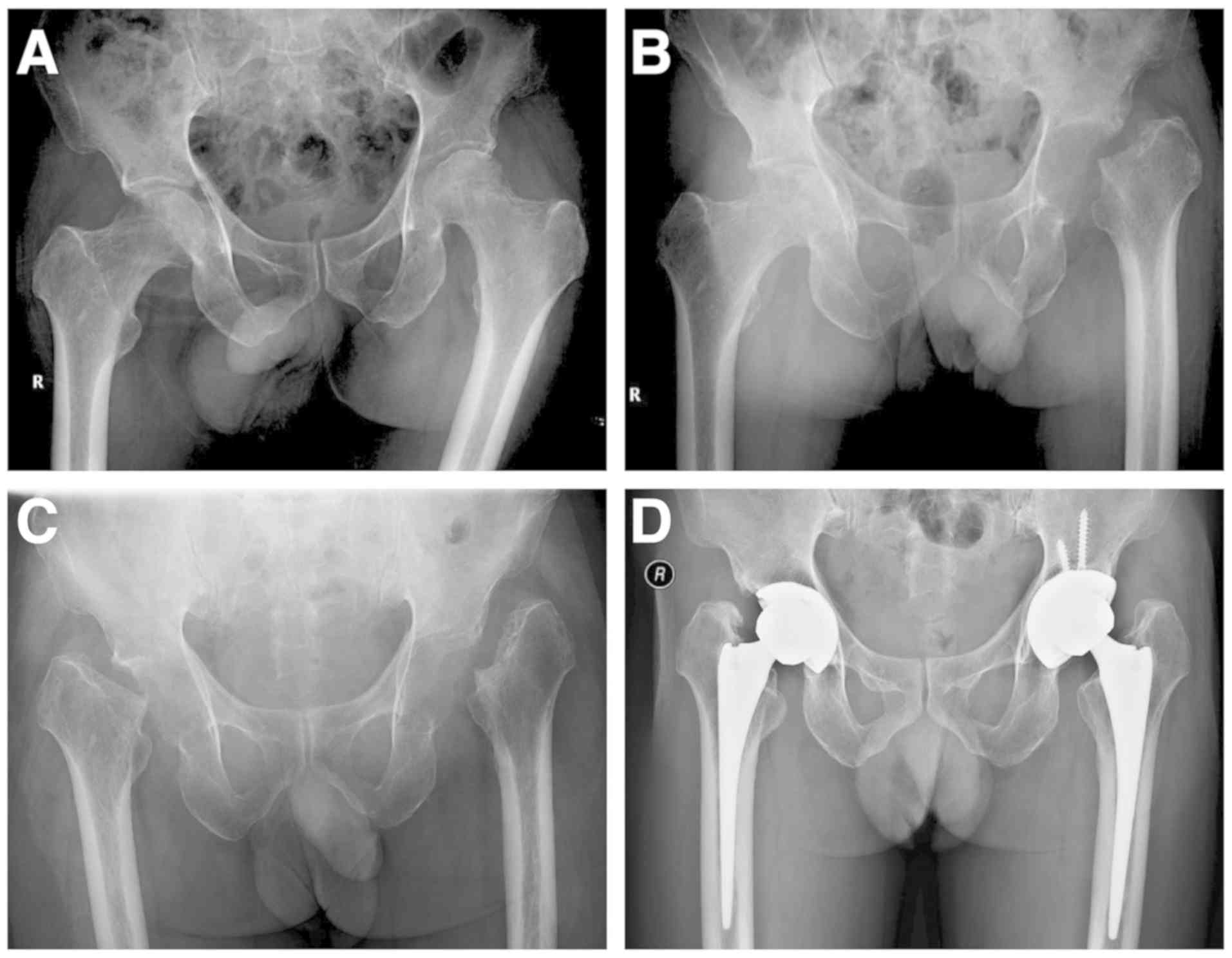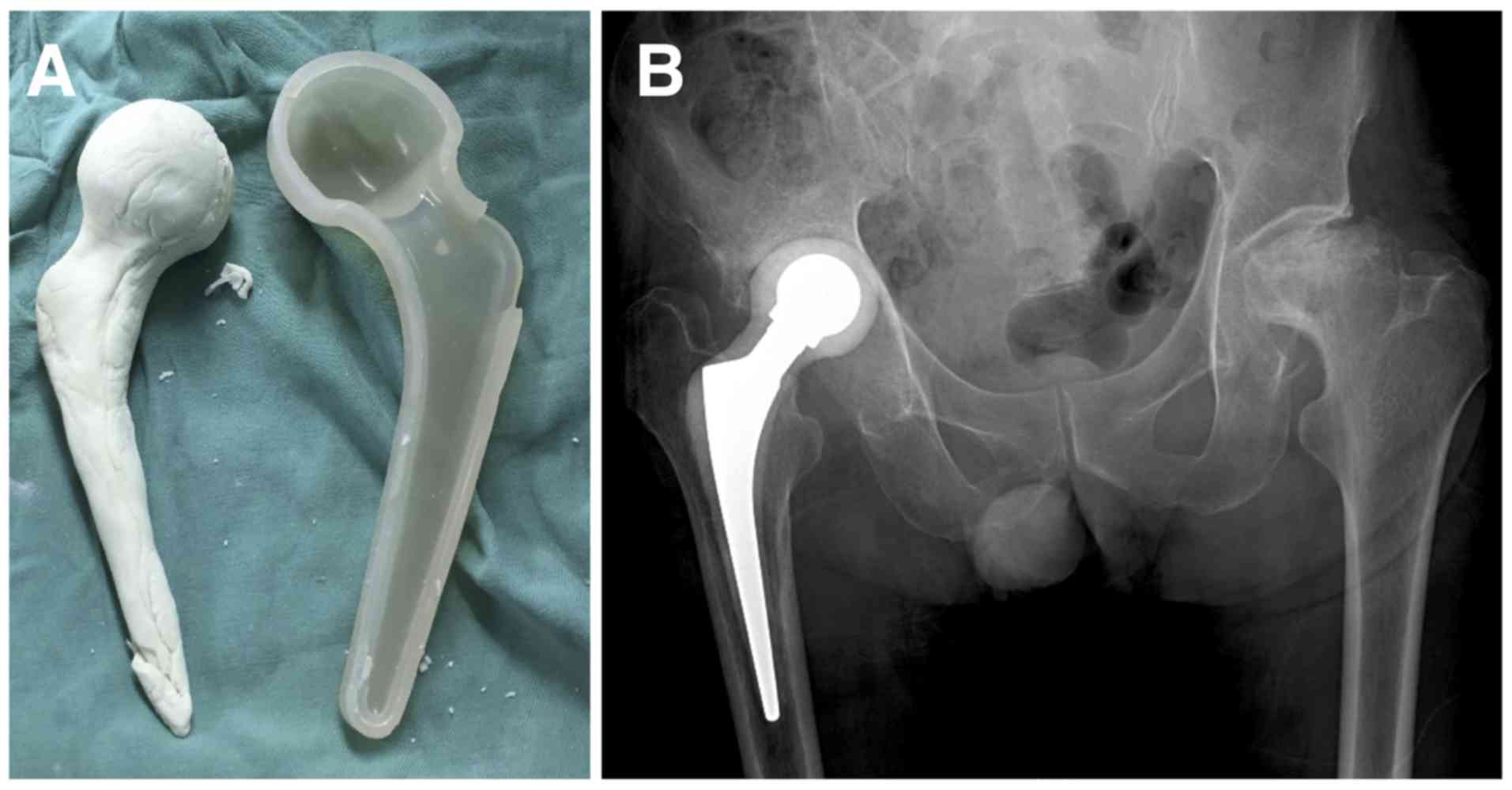|
1
|
Diwanji SR, Kong IK, Park YH, Cho SG, Song
EK and Yoon TR: Two-stage reconstruction of infected hip joints. J
Arthroplasty. 23:656–661. 2008. View Article : Google Scholar : PubMed/NCBI
|
|
2
|
Souza Miyahara Hd, Helito CP, Oliva GB,
Aita PC, Croci AT and Vicente JR: Clinical and epidemiological
characteristics of septic arthritis of the hip, 2006 to 2012, a
seven-year review. Clinics (Sao Paulo). 69:464–468. 2014.
View Article : Google Scholar : PubMed/NCBI
|
|
3
|
Vukasinović Z, Spasovski D, Cobeljić G and
Zivković Z: Septic arthritis of the hip in infancy-diagnostic and
therapeutic possibilities. Srp Arh Celok Lek. 134:77–81. 2006.(In
Serbian). PubMed/NCBI
|
|
4
|
Stutz G, Kuster MS, Kleinstück F and
Gächter A: Arthroscopic management of septic arthritis: Stages of
infection and results. Knee Surg Sport Traumatol Arthrosc.
8:270–274. 2000. View Article : Google Scholar
|
|
5
|
Harrison MH: Robert Jones, Gathorne
Girdlestone and excision arthroplasty of the hip. J Bone Joint Surg
Br. 87:13062005. View Article : Google Scholar : PubMed/NCBI
|
|
6
|
Malcolm TL, Gad BV, Elsharkawy KA and
Higuera CA: Complication, survival, and reoperation rates following
girdlestone resection arthroplasty. J Arthroplasty. 30:1183–1186.
2015. View Article : Google Scholar : PubMed/NCBI
|
|
7
|
Cui Q, Mihalko WM, Shields JS, Ries M and
Saleh KJ: Antibiotic-impregnated cement spacers for the treatment
of infection associated with total hip or knee arthroplasty. J Bone
Joint Surg Am. 89:871–882. 2007. View Article : Google Scholar : PubMed/NCBI
|
|
8
|
Assmann G, Kasch R, Maher CG, Hofer A,
Barz T, Merk H and Flessa S: Comparison of health care costs
between aseptic and two stage septic hip revision. J Arthroplasty.
29:1925–1931. 2014. View Article : Google Scholar : PubMed/NCBI
|
|
9
|
Kim YS, Bae KC, Cho CH, Lee KJ, Sohn ES
and Kim BS: Two-stage revision using a modified articulating spacer
in infected total knee arthroplasty. Knee Surg Relat Res.
25:180–185. 2013. View Article : Google Scholar : PubMed/NCBI
|
|
10
|
Sandiford NA, Duncan CP, Garbuz DS and
Masri BA: Two stage management of the infected total hip
arthroplasty. Hip Int. 25:308–315. 2015. View Article : Google Scholar : PubMed/NCBI
|
|
11
|
Anagnostakos K, Duchow L and Koch K:
Two-stage protocol and spacer implantation in the treatment of
destructive septic arthritis of the hip joint. Arch Orthop Trauma
Surg. 136:899–906. 2016. View Article : Google Scholar : PubMed/NCBI
|
|
12
|
Fleck EE, Spangehl MJ, Rapuri VR and
Beauchamp CP: An articulating antibiotic spacer controls infection
and improves pain and function in a degenerative septic hip. Clin
Orthop Relat Res. 469:3055–3064. 2011. View Article : Google Scholar : PubMed/NCBI
|
|
13
|
Romanò CL, Romanò D, Meani E, Logoluso N
and Drago L: Two-stage revision surgery with preformed spacers and
cementless implants for septic hip arthritis: A prospective,
non-randomized cohort study. BMC Infect Dis. 11:1292011. View Article : Google Scholar : PubMed/NCBI
|
|
14
|
Shen H, Wang QJ, Zhang XL and Jiang Y:
Novel articulating medullary-sparing spacer for the treatment of
infectious hip arthritis. Orthopedics. 36:e404–e408. 2013.
View Article : Google Scholar : PubMed/NCBI
|
|
15
|
Osmon DR, Berbari EF, Berendt AR, Lew D,
Zimmerli W, Steckelberg JM, Rao N, Hanssen A and Wilson WR;
Infectious Diseases Society of America, : Diagnosis and management
of prosthetic joint infection: Clinical practice guidelines by the
infectious diseases Society of America. Clin Infect Dis. 56:e1–e25.
2013. View Article : Google Scholar : PubMed/NCBI
|
|
16
|
Mirra JM, Amstutz HC, Matos M and Gold R:
The pathology of the joint tissues and its clinical relevance in
prosthesis failure. Clin Orthop Relat Res. 221–240. 1976.PubMed/NCBI
|
|
17
|
Spangehl MJ, Masri BA, O'Connell JX and
Duncan CP: Prospective analysis of preoperative and intraoperative
investigations for the diagnosis of infection at the sites of two
hundred and two revision total hip arthroplasties. J Bone Joint
Surg Am. 81:672–683. 1999. View Article : Google Scholar : PubMed/NCBI
|
|
18
|
Mahomed NN, Arndt DC, McGrory BJ and
Harris WH: The Harris hip score: Comparison of patient self-report
with surgeon assessment. J Arthroplasty. 16:575–580. 2001.
View Article : Google Scholar : PubMed/NCBI
|
|
19
|
Rittmeister M, Müller M, Starker M and
Hailer NP: Functional results following Girdlestone arthroplasty. Z
Orthop Ihre Grenzgeb. 141:665–671. 2003.(In German). View Article : Google Scholar : PubMed/NCBI
|
|
20
|
Fenelon GC, Von Foerster G and Engelbrecht
E: Disarticulation of the hip as a result of failed arthroplasty. A
series of 11 cases. J Bone Joint Surg Br. 62-B:441–446. 1980.
View Article : Google Scholar : PubMed/NCBI
|
|
21
|
Petty W and Goldsmith S: Resection
arthroplasty following infected total hip arthroplasty. J Bone
Joint Surg Am. 62:889–896. 1980. View Article : Google Scholar : PubMed/NCBI
|
|
22
|
Charlton WP, Hozack WJ, Teloken MA, Rao R
and Bissett GA: Complications associated with reimplantation after
girdlestone arthroplasty. Clin Orthop Relat Res. 119–126. 2003.
View Article : Google Scholar : PubMed/NCBI
|
|
23
|
Huang TW, Huang KC, Lee PC, Tai CL and
Hsieh PH: Encouraging outcomes of staged, uncemented arthroplasty
with short-term antibiotic therapy for treatment of recalcitrant
septic arthritis of the native hip. J Trauma. 68:965–969.
2010.PubMed/NCBI
|
|
24
|
Hsieh PH, Chang YH, Chen SH and Shih CH:
Staged arthroplasty as salvage procedure for deep hip infection
following intertrochanteric fracture. Int Orthop. 30:228–232. 2006.
View Article : Google Scholar : PubMed/NCBI
|
|
25
|
Romanò CL, Romanò D, Logoluso N and Meani
E: Long-stem versus short-stem preformed antibiotic-loaded cement
spacers for two-stage revision of infected total hip arthroplasty.
Hip Int. 20:26–33. 2010. View Article : Google Scholar : PubMed/NCBI
|
|
26
|
Regis D, Sandri A, Rizzo A and Bartolozzi
P: A preformed temporary antibiotic-loaded cement spacer for the
treatment of destructive septic hip arthritis: A case report. Int J
Infect Dis. 14:e259–e261. 2010. View Article : Google Scholar : PubMed/NCBI
|
|
27
|
Ganzoury IE and Eid AS: Two-stage
arthroplasty using functional temporary prosthesis to treat
infected arthroplasty and septic arthritis of the hip. J Orthop. 12
(Suppl 1):S86–S93. 2015. View Article : Google Scholar : PubMed/NCBI
|
|
28
|
Fink B, Grossmann A, Fuerst M, Schäfer P
and Frommelt L: Two-stage cementless revision of infected hip
endoprostheses. Clin Orthop Relat Res. 467:1848–1858. 2009.
View Article : Google Scholar : PubMed/NCBI
|
|
29
|
Masri BA, Panagiotopoulos KP, Greidanus
NV, Garbuz DS and Duncan CP: Cementless two-stage exchange
arthroplasty for infection after total hip arthroplasty. J
Arthroplasty. 22:72–78. 2007. View Article : Google Scholar : PubMed/NCBI
|
|
30
|
Fehring TK, Odum S, Calton TF and Mason
JB: Articulating versus static spacers in revision total knee
arthroplasty for sepsis. The ranawat award. Clin Orthop Relat Res.
9–16. 2000. View Article : Google Scholar : PubMed/NCBI
|
|
31
|
Sanchez-Sotelo J, Berry DJ, Hanssen AD and
Cabanela ME: Midterm to long-term followup of staged reimplantation
for infected hip arthroplasty. Clin Orthop Relat Res. 467:219–224.
2009. View Article : Google Scholar : PubMed/NCBI
|
|
32
|
Rutz E and Spoerri M: Septic arthritis of
the paediatric hip-A review of current diagnostic approaches and
therapeutic concepts. Acta Orthop Belg. 79:123–134. 2013.PubMed/NCBI
|

















